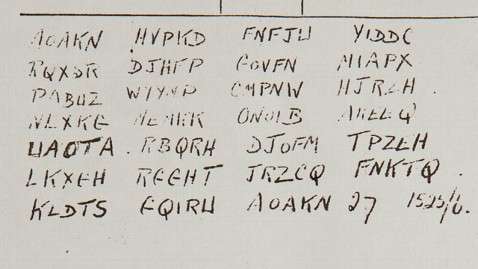December 17, 2012 report
Canadian says he unraveled WWII pigeon code

(Phys.org)—British intelligence officials were baffled last month by a secret World War II message which a man had discovered on the leg of a dead pigeon when renovating his chimney in Surrey, England. He had found pigeon parts including a leg to which was attached a paper of character-string code, in the form of 27 handwritten blocks. Now they are being told by a Canadian researcher that they can stop scratching their heads. He said he has figured out most of it. What he was unable to crack was possibly parts deliberately planted to dupe the German enemies if they got hold of the note.
Britain used some 250,000 pigeons as its messengers during the war. The National Pigeon Service was a squadron of 250,000 birds flying at speeds of 80 mph, covering thousands of miles using their navigational skills to get their messenger jobs done. The Surrey discoverer handed the paper over to intelligence agency GCHQ.
Codebreakers determined that the message handed over to them was impossible to crack without its code book, as code books and computers were destroyed after the war, and they were convinced the message would be impossible to decrypt without reference to the original cryptographic material. Without access to the relevant code books and details of any additional encryption used, the message would remain impossible to decrypt, a spokesman said.
The latest news is that the Canadian, Gord Young of Peterborough, Ontario, now believes he has the answer, nonetheless. The puzzle took him 17 minutes to figure out, with the aid of a book that he inherited, according to the BBC. He used his great-uncle's Royal Flying Corp [92 Sqd-Canadian] aerial observers' book to piece out the message.
Young said the note utilized a simple code to detail German troop positions in Normandy. The note was written by a Lancashire fusilier who had been parachute-dropped into Normandy with pigeons to report on German positions. The man was killed a few weeks later.
Young said that the short form code relied mostly on acronyms, most of which he unraveled. "The message is indeed breakable."
The message told RAF officers what the situation was on the ground after being parachuted behind enemy lines. Some sample portions of the message were said to read: "Artillery observer at 'K' Sector, Normandy…Final note [confirming] Found Jerry's whereabouts… Panzer attack - blitz. Know [where] local dispatch station."
Young is the editor of a local history group, the Lakefield Heritage Research, which has a collection of photocopies and other forms of information related to Peterborough's history, from both city and county.
More information: via BBC
© 2012 Phys.org




















